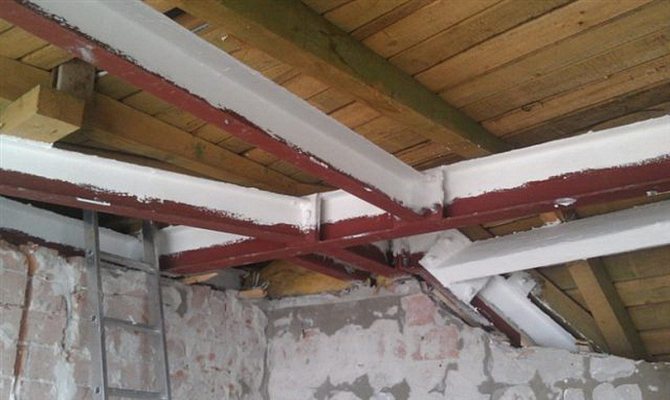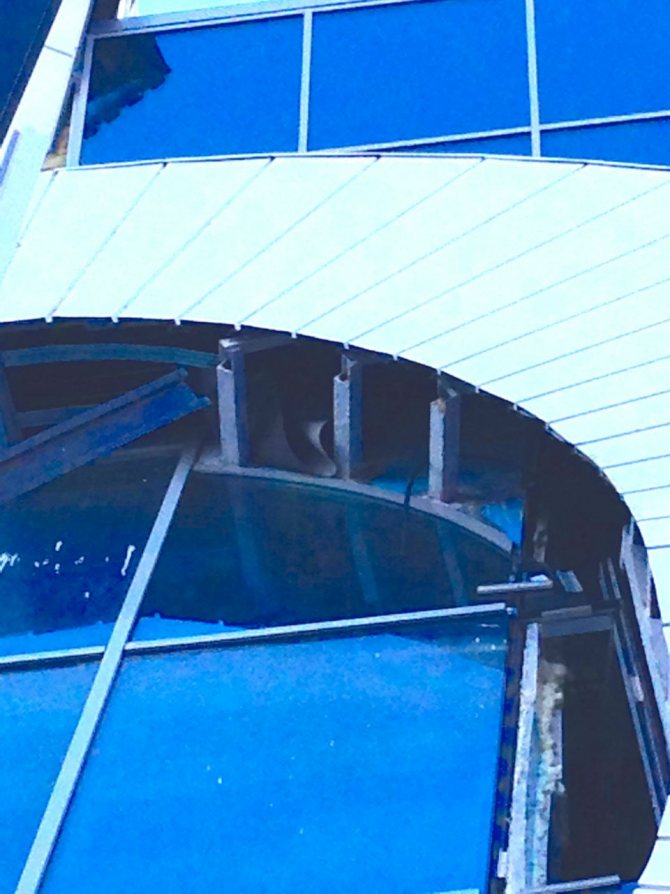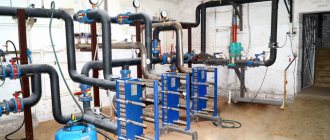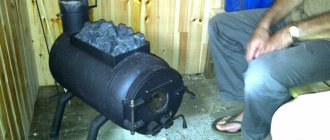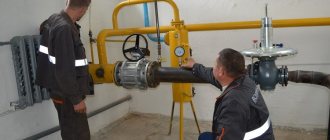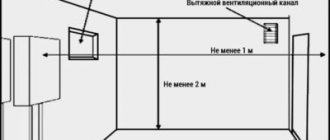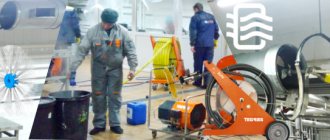Thermal insulation of metal structures
AKTERM Metal
The heat-and-energy-saving coating is used for thermal insulation of metal structures, tanks, containers, pipelines, furnaces with operating temperatures up to +200 ° С. Effectively reduces heat loss, eliminates condensation and freezing, protects against corrosion, improves the microclimate in boiler rooms, and ensures the safety of personnel from burns.
More details
AKTERM ® for metal structures and roofs.
Fire protection of metal structures
Being a constructive method of protection, the system provides a high fire resistance up to 4 hours, as well as thermal insulation and a long service life of metal structures. Before proceeding with the installation of the Conlit 150 SL fire-retardant material, it is necessary to properly prepare the surface of the protected structure. Steel surfaces must be dry, free of oil and other components, degreased and primed.
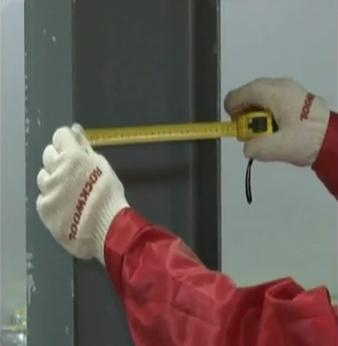
After preparing the surface to be protected, it is necessary to prepare inserts from Conlit fire protection boards. To do this, we cut the bars, the minimum dimensions of which should be 100 mm in width and 50 mm in thickness. The length of the bar should exceed the distance between the flanges of the I-beam by 3-5 mm.
On the ends of the prepared stakes, a layer of pre-prepared fire-retardant glue Conlit Glu is applied. Before applying Sealeks, the glue is thoroughly mixed for 2-3 minutes. Using a trowel or spatula, a layer of glue of at least 2 mm is applied to the end faces of the inserts. Then the bar is inserted between the shelves of the I-beam and in such a way that its surface protrudes 2-3 mm beyond the border of the metal structure.
The distance between the inserts using the "fire protection of structures" system should not exceed 1000 mm. After 12 hours, after complete drying of the Conlit Glu fire-retardant glue, the structure is ready for the main installation, the main fire-retardant layer. The thickness of Rockwool Conlit 150 SL mineral slabs is determined on the basis of the required fire resistance limit (Conlit calculator) and the given thickness of metal structures.
Fire protection of steel structures is an important process that requires the use of special materials such as Conlit boards. During their installation, Conlit Glu glue is dotted on the prepared plates, after which the plates are glued to the inserts. The front surface of the inserts should also be treated with fire retardant glue. Until full adhesion is achieved, the mineral wool boards are fixed with nails, the number of which is 2-3 pieces per insert. After 12 hours, the nails can be removed from the fire retardant boards or covered with Conlit Glu special glue. After that, we coat all the joints between the plates with glue. Conlit Glu consumption is about 1 kg per 1 m2 of protected surface.
The application of a thin plaster layer is one of the options for giving an aesthetic appearance to a fireproof structure. Before the application of ROCKWOOL ROCKmortar reinforcing putty, it is dissolved with water at a rate of 1 liter per 5 kilograms of dry mix and thoroughly mixed. For this, a drill with a mixer attachment is best suited, which must be worked for 2-3 minutes, until a homogeneous mass is achieved. The base coat is applied to the surface of the fire retardant board with the smooth side of the trowel. After application, the mortar is leveled with a notched trowel. Thus, a homogeneous layer of 3-4 mm is obtained. Putty consumption is 4 kg / m2.
To achieve greater impact resistance, the surface of the base layer with the fire protection system of metal structures is reinforced with ROCKfiber fiberglass mesh manufactured by ROCKWOOL. All external corners are reinforced with a special corner profile made of pvc mesh. Not earlier than one day after reinforcement, you can proceed to applying a decorative plaster layer, for example, with ROCKdecor mineral plaster.
To give the required shade, it is possible to paint a decorative layer of plaster.
Video fire protection of metal structures
Buy Wired Mat Rockwool
+7,
It might be interesting:
| |
| |
| |
| |
|
LLC GK "TEPLOSILA" - together with you since 2005!
AKTERM Anticor
AKTERM Anticor ™ is an ultra-thin liquid thermal insulation with anticorrosive properties on an organic solvent. It is used for thermal insulation and anti-corrosion protection of metal structures, metal products and spare parts, tanks, pipelines, transport, etc.
More details
According to the laws of physics, warm air rises upward, thus, large heat losses occur due to the absence roof insulation or insufficiently effective properties used thermal insulation material. Even if the roof or attic is not used as a living space, they must be reliably insulated. to protect against the negative effects of wind, sunlight, low and high ambient temperatures... All these factors increase heat loss and increase the cost of heating and maintenance of the interior.
Good thermal conductivity of metal can lead to a fatal side effect - the appearance of "thermal bridges", which also increase the loss of heat energy and damage construction. A "thermal bridge" is a part of the enclosing structure that has a higher thermal conductivity than the main metal structure. Examples: protruding balcony slab, building canopy, etc. "Thermal bridges" lead to a decrease in the temperature of the inner surface of the building, as a result of which increased humidity inside the building envelope.
Effective insulation of roofs and metal structures helps in solving the following tasks:
- Effectively combats thermal bridges;
- Helps prevent heat flow in metal beams;
- Protects metal from corrosion;
- Retains heat energy in winter and reduces heating in summer;
- Reduces thermal stress and potential damage to load-bearing metal structures;
- Protects against condensation;
- Protects against overheating and hypothermia to reduce the cost of heating and air conditioning premises, warehouses;
- Provides fire protection;
- Helps to increase the service life.
Liquid insulation AKTERM ® suitable for all types of metal and various roof structures. Does not require additional fasteners and does not create additional stress on metal structures. Thanks to its texture and innovative properties, liquid thermal insulation AKTERM ® easy to apply even to hard-to-reach areas, creating a smooth, neat surface. The finishing layer AKTERM ™ can be painted in any decorative color, it is also possible to apply logos and names.
heat-insulating polymer coating ASTRATEK® metal
Surface preparation
The insulated surface must be cleaned from rust, scale, dirt by a mechanized method or manually with metal brushes and free from dust. In the case of untreated grease stains, degrease it with solvent 646, 647. In case of severe corrosion, treat the surface with a rust converter based on phosphoric acid (15% solution of water and phosphoric acid).When a phosphate "whitish" film forms on a metal surface, wash off the acid residues with water, thus forming a protective layer of the surface of a "whitish" color. When applying to a previously painted surface, it is necessary to remove the old paint in places of peeling and peeling. Sand if necessary with medium to coarse sandpaper.
Padding
To improve adhesion and increase the service life of the finished coating, it is recommended to prime the metal metal surfaces before applying the ASTRATEC thermal insulation coating. When covering "cold" metal surfaces (not lower than + 5 ° С), it is recommended to use a GROSS metal primer (1-2 layers) or another high-quality acrylic metal primer. For a non-ferrous metal surface, it is necessary to use a special primer for non-ferrous metals, such as VL-023. When covering hot (more than + 80 ° C) metal surfaces, it is recommended to use a 20-25% aqueous solution of ASTRATEK metal as a primer layer.
3.1. It is recommended to apply the coating at a temperature of the insulated surface within the range from + 5 ° C to + 120 ° C.
3.2. It is not recommended to apply ASTRATEK metal coating on surfaces with a residual moisture content of more than 8%, in strong wind, rain, fog, frost.
3.3. When applying the ASTRATEK metal heat-insulating coating, you should pay attention to the following points: It is recommended to apply ASTRATEK metal on “cold” metal surfaces at an ambient temperature of + 5 ° C and a humidity of no more than 65%. The lower the relative humidity of the air, the faster the material dries and, accordingly, the higher the humidity, the longer the drying time. On clean, polished metal surfaces, steam condenses into moisture at a humidity of more than 90%. On rough or uncleaned surfaces, condensation occurs even at a humidity of 65-70%. In addition, condensation can settle on the surface even at low humidity, if the temperature of the metal is lower than the air temperature. Therefore, the surface must be dried naturally or forcibly before application. It should be remembered that when the temperature drops below + 20 ° C and the humidity rises to 85%, the drying time increases. Therefore, it is necessary to increase the time between application of layers by at least 2-3 times. For example, a material that has dried at low temperatures appears to be ready after the formation of a film, although the film will become completely strong only after all the water has evaporated and the film formation is completely completed. High ambient temperatures significantly accelerate water evaporation and curing. In this case, only the top layer can dry out and "preserve" water vapor inside, which, in turn, will worsen the thermal insulation and operational characteristics of the finished coating. At the same high temperature of the ambient air and surface, this, as a rule, does not happen, therefore, in the summer, it is recommended to carry out work only in the morning in order to avoid a significant difference in metal and air temperatures. Drying of the applied layer with a directed jet of heated air on the surface of the coating is also unacceptable. Before using ASTRATEK, the metal must be thoroughly mixed until a homogeneous mass is obtained. With mechanical stirring, the rotational speed should not exceed 300 rpm. If necessary, dilution with clean water of 3 - 7% of the total volume is allowed. The resulting composition must be periodically mixed during operation.
3.4. The coating is applied in layers with a brush, air or airless spray, subject to the interlayer drying technology, at a temperature of t = 20 ± 2 ° C and above and a relative humidity of no more than 65%.The thickness of the applied layer should not exceed 0.5 mm, the final thickness of the ASTRATEK metal heat-insulating coating is determined by the method of heat engineering calculation. The time for complete drying of each applied layer with a thickness of 0.3-0.5 mm is 24 hours. The time for complete drying of the finished coating depends on the number of layers, temperature and humidity of the ambient air. If necessary, the interlayer drying time should be increased by 2-3 times. The cover is resistant to rain after 24 hours. 3.5. Brush application. It is recommended to use a non-natural bristle brush for applying interior or facade paints, as well as for painting small surfaces and correcting color imperfections. Moisten the brush with water immediately before applying the material. When applying with a brush, the movements should be directed in one direction to obtain a good coverage. Recommendations for applying the coating with an air or airless spray, as well as the necessary advice on the selection of the necessary equipment, can be obtained from our technical specialists by phone +7 (8442) 47-70-30 ,. Rinse working tools with water after application. The finished coating can be coated with GROSS facade acrylic paint or other high-quality acrylic paints. For additional protection of the finished coating from constant contact with aggressive media, we recommend applying UREPLEN® polyurethane coating on top.
Consumption
The consumption of ASTRATEK metal heat-insulating coating depends on the method of application, the shape of the surface and is more accurately determined by a trial application. Average consumption is: 1-1.3 l / m2, depending on the method of application and the properties of the insulated surface (with a finished coating thickness of 1 mm).
Precautions and Disposal
Heat-insulating polymer coating ASTRATEK metal is fire-safe and explosion-proof, does not contain solvents, does not require special precautions in handling it. In case of contact with eyes, rinse immediately with water. Do not allow to enter waste water. Keep out of the reach of children. Carry out work in a ventilated area. Dispose of material residues after drying as household waste. The material is water-soluble, the addition of organic solvents is not allowed.
Storage and transportation
Thermal insulating polymer coating ASTRATEK metal should be stored in a tightly closed container at temperatures from + 5 ° C to + 35 ° C, away from direct sunlight. Material marked "frost-resistant" can be transported and stored at temperatures up to -40 ° C for one month. 5 freezing cycles are allowed.
Manufacturer's Warranties
The manufacturer guarantees that ASTRATEK metal heat-insulating polymer coatings comply with the technical characteristics when following the rules of transportation, storage, preparation and application, which are given in these recommendations and technical descriptions for each specific type of coating. The guaranteed shelf life in original unopened packaging is 12 months from the date of production. The manufacturer is not responsible for the improper use of the material, as well as for its use for other purposes and conditions not provided for in the technical documents. Professional technical advice, the necessary documentation, information on the features of the use of each specific type of heat-insulating polymer coating can be obtained from technical support specialists by phone, +7 (812) 332-84-31.
Consumption
(1.0 - 1.6) l / m2 depending on the condition of the substrate and the method of application
Delivery form
Plastic buckets 3L, 10L, 20L.
__________________________________________________
Individual approach
Company consultants AKTERM we are ready to help you in the selection of liquid thermal insulation depending on the characteristics of the roof of buildings and structures, the type of metal structures and the requirements for the expected result after using liquid thermal insulation.
For insulation of metal structures, modifications are recommended:
- AKTERM Metal ™ - for application on metal surfaces
- AKTERM Anticor ™ - for high quality anticorrosive treatment
- AKTERM Hydrophobizator ™ - for waterproofing
- AKTERM Vulcan ™ - for application on high-temperature metal surfaces
- AKTERM Nord ™ - for use in winter
- AKTERM Anti-condensate ™ - for protection against condensation
- AKTERM Standard ™ - for universal heat, thermal and water protection
- AKTERM Plast ™ - primer-enamel with the effect of "liquid plastic"
Types of heaters
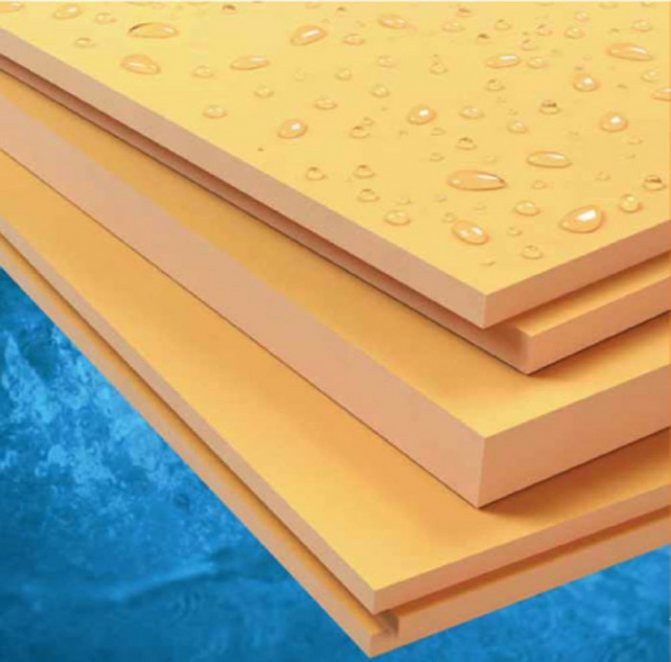

Expanded polystyrene is one of the best heaters on the modern thermal insulation market: a high degree of thermal insulation, does not rot, does not allow moisture to pass through.
Penoizol is a well-known and inexpensive material since the last century. Has a porous fine-mesh structure. Pleasantly pleased with the cheapness. It can be used both in sheet form and by filling.
Fiberglass or glass wool - consists of long and wide fibers, between which there are a large number of voids, and the voids are filled with air. This ensures good thermal insulation as well as noise protection. The material is strong and resilient, tolerates vibration well, and is durable. Fiberglass does not absorb water, while letting in steam, is resistant to chemical and biological influences, does not burn. It is used for thermal insulation of metal structures of wooden houses, roofs.
Basalt mineral wool is produced from basalt melts, therefore it is characterized by a very long service life. It does not change its properties under the influence of an aggressive chemical environment or high temperature, while being safe for humans, since it does not emit toxic substances.
